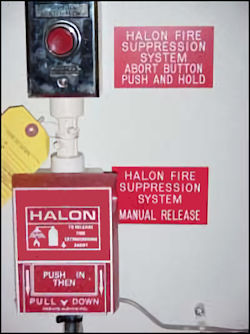Hazards of Carbon Dioxide and Halon Systems
Agents used for initial supply and replenishment shall be of the type approved for the system's application.
Carbon dioxide obtained by dry ice conversion to liquid is not acceptable unless it is processed to remove excess water and oil.
Hazardous effects created by exposure to CO2 and halon include:
- Asphyxiation - Exposure to high concentrations of CO2 or halon gas may create an oxygen-deficient atmosphere.
- Frostbite - Direct contact with the vaporizing liquid during discharge can cause frostbite burns to the skin.
Hazardous effects created by exposure to halon include:
- Central Nervous System (CNS) Effects: Inhaling high concentrations of halon gas can cause dizziness, tingling in extremities and, in severe cases, unconsciousness.
- Cardiovascular Effects: In some people, exposure to halon can cause an increased sensitivity of the heart to adrenaline resulting in irregular heartbeats and, in severe cases, heart attack.
- Toxic Effects: When halon is exposed to temperatures above 900 degrees F. it could break down and create high concentrations of toxic gases.
See the Fixed Extinguishing Systems Checklist.
Knowledge Check Choose the best answer for the question.
3-7. What hazardous effects may be created by exposure to CO2 and halon?
You forgot to answer the question!

